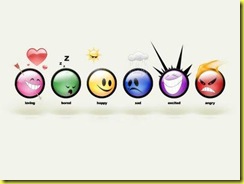I commented in Jenny's post about Complexity-Chaos:
"as soon as I placed my wall out there in my week 5 post it became real and I could start tearing it down. I expected more uncertainty this week just from the subject “Chaos and Complexity” and I found instead, to my surprise, peace".
"In this experiment we were plunged in to chaos in order to live connectivism , there is no other way to understand it, we have to live it."
I won't try to explain how I got from chaos to peace. I saw so many patterns this week that it would be messy.
My post was featured in the Daily in a very clever way. That fact itself triggered something that took me back to my reaction to the first of Jenny's posts I read. The comments left in my blog opened doors, the October 15th morning live session had a deep impact on me, I kept listening and typing my ideas. I copied the entire chat and spend hours in a notepad file I called "provoking comments" (copy/paste), making more sense moving reactions along until I saw a distinct pattern. Then, if I remember well, I left comments in Iamar's post and Gina's post among others that right now I don't recall but with each visit the wall started to crumble. My reactions flowed easily in the comments area.
It became clear for me that my reaction to finding Jenny as a person that I resonate with was crucial. In my first comment to her I told her: "When I joined the course I wanted to learn about Connectivism, it seems that I am living it, that’s what this experiment is about."
Then I saw that indeed, there is a vicarious reinforcement pattern in the lack of comments and that somehow Gina was perceiving it too, she touched the same feeling of being ushered to behave in certain ways in order to have access to information and she called that "FILTERS". I also realized that there is nothing wrong with that. On Friday's live Ustream session almost everything fell into place. As Stephen mentioned
"TRY TO FIND PATTERNS AND RECOGNIZE THEM, IF IT'S NOT RECOGNIZED YOU REACT IN A KIND OF AUTISTIC WAY." "LEARNING AND KNOWING IS PATTERN RECOGNITION, YOU CANNOT TELL PEOPLE, THEY HAVE TO LIVE IT, EITHER THEY RECOGNIZE IT OR NOT".
I saw clearly how clever both are designing an experiment that would lead you to live connectivism. You live it in such a way that the concept cannot be described with words.
Moreover, today at our SLExperiments Weekly meeting an non expected of event happened. I had two new members lost in-world, one contacting me on Twhirl and we did not know her SL name and another one with SL IMs who missed the teleports sent. 
As soon as I told the group I saw a fantastic display of resources from all the members, email, twitter, SIM, wikipages, IMs, Google Groups, etc. As Dave White explains in his video about Multivisual Environments for Online Distance learning (Second Life for example), Aspects of Community. There were some shades of Confusion, Performance, Drama, Frustration and Celebration. We thought each other, there was a feeling of belonging, the lost members felt cared for, there was a natural engagement, high level of trust and persistence to complete the task at hand.
That is a true learning community, I am very proud to belong to it and I celebrate myself for having started those meetings. I wonder if we will celebrate 10 years as Webheads did.
Reading Collectives, Networks and Groups in Social Software for E-Learning I saw that what I have done so far at Becoming an e-Learner site, considering my lack of experience, it's not so bad, with time practice and connective participation it will become better. It's plain chaos.
The rigid but reliable BaeL Yahoo Group appealed to teachers but not to the teenagers. Also, they are used to MSN chat, the moving icons tug at them in a fantastic way but as I had seen that that environment does not hold more than 70 people using voice and I wanted them to speak I choose YH Messenger: Huge mistake. After exploring several venues, mainly opening sites and showing them to the kids of the block I chose Ning. It appealed to them, so I started my long boring still unfinished task of translating the platform which is still in Spanglish. Well, it is bilingual! LOL
In conclusion, I have found that human contact, affection and caring are very important to develop a learning network. I am eager to know how these guys sort out the point of assessment, evaluation or whatever you wan to call it.
By the way, I have not seen, received and email, a tweet or something to tell me about the grading of my first paper.
Never mind, maybe in Connectivism the responsibility to hand out grades doesn't fall on the "teacher's" shoulders. Who knows? Maybe it will arrive by regular email like my subscription. Surely I will know any time in 2009.
Well, off to SLP. I miss the place dearly. Long walks on broad clean sidewalks looking at grandiose colonial houses, endless pedestrian narrow streets leading every two blocks to a plaza with a church, fountains and gardens. No rain!! Warm weather, warm people, f2f kisses, hugs and laughter. Great celebration among a blood group... FAMILY!! :-)
No rain!! Warm weather, warm people, f2f kisses, hugs and laughter. Great celebration among a blood group... FAMILY!! :-)












